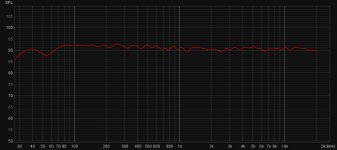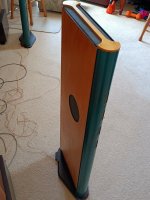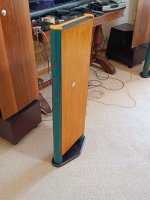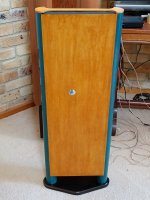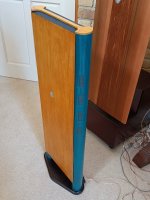Looking forward to hearing your results. It may have good potential. If it is expanded polyethylene, it will be light and rigid - ideal for our panels. The cut to size option looks like it has rounded corners - great if true!Hi. Eric,
I contacted the company and asked them to confirm. They told me it was expanded polyethylene so on that basis I have ordered a sample. I’ll update when I get the sample.
Burnt
aagas,
You might want to check these guys out for panel material https://www.yourartsupplies.com/canvas/panels/alumacomp-panels.html I made a pair of panels from their 18" x 24" and was not that impressed with the sound.
I am just not that impressed with the "DML sound" But if you like the sound these are a pretty good value for the size. They were brighter than the gator board of the same size and even the cortex panels of the same size and thickness.
Cheers.
You might want to check these guys out for panel material https://www.yourartsupplies.com/canvas/panels/alumacomp-panels.html I made a pair of panels from their 18" x 24" and was not that impressed with the sound.
I am just not that impressed with the "DML sound" But if you like the sound these are a pretty good value for the size. They were brighter than the gator board of the same size and even the cortex panels of the same size and thickness.
Cheers.
You might like this patent. 🙂I have made some prototypes along these lines i.e. BMR. I have used a regular 7 inch foam surround in both cases. The diaphragm is 2mm balsa an CF. The black one is 3D printed as you can see. It uses the tectonic driver as I have used in previous speaker. The box is a reversed exponential horn , similar to B&W nautilus.
The other is using a sallads bowl from ikea🤪 and an exciter from dayton (It is closed box).
View attachment 1131709View attachment 1131710View attachment 1131711View attachment 1131718
It is not DML, though.
I have a Dibond plate just like that. It's too heavy and hence the efficiency is too low. It's lighter than solid aluminum, but not enough for me.I can get something like this,
View attachment 1132524 View attachment 1132525
3mm composite sheet, two 0.3mm aluminium sheet bonded with expanded polyethylene called Dibond cut to size, already covered with foil on both sides, factory pressed. That's how they normally sell, anyway. 🙂
About 20EUR for 2 sheets 40cm x 60cm including transport. Even, if I buy in 3-4 months time, it won't cost more, if at all few EUR.
The idea of foil cover comes from registered patents. 🙂
The only thing of this sort (aluminum skin composite) that I've tried and liked at all was 6 mm Alumalite (actually measured 5.3 mm).
https://www.laminatorsinc.com/sign-panels/products/alumalite®-standard
Alumalite has a corrugated PP core, so it's lighter than Dibond. The "effective" density ends up about the same as plywood, but it's stiffer than plywood of the same thickness. That stiffness is good for efficiency but the downside is that either the panel has to be pretty large, or you have to be satisfied with a relatively high crossover frequency. I suspect Alumalite is kind of close to aagas's honeycomb core aluminum panels.
Is see they have a 5 mm nominal "economy" panel now that they didn't have before. That's the one I'd pick now.
Eric
What about the Alumalite's polypropylene core? How does it sound?I have a Dibond plate just like that. It's too heavy and hence the efficiency is too low. It's lighter than solid aluminum, but not enough for me.
The only thing of this sort (aluminum skin composite) that I've tried and liked at all was 6 mm Alumalite (actually measured 5.3 mm).
https://www.laminatorsinc.com/sign-panels/products/alumalite®-standard
Alumalite has a corrugated PP core, so it's lighter than Dibond. The "effective" density ends up about the same as plywood, but it's stiffer than plywood of the same thickness. That stiffness is good for efficiency but the downside is that either the panel has to be pretty large, or you have to be satisfied with a relatively high crossover frequency. I suspect Alumalite is kind of close to aagas's honeycomb core aluminum panels.
Is see they have a 5 mm nominal "economy" panel now that they didn't have before. That's the one I'd pick now.
Eric
Would be happy find some aluminium honeycomb sheets, though. aagas was simply lucky!
It's been a long time since I listened to it, but as I recall there was nothing objectionable except the lack of LF, since the panel was not large enough.What about the Alumalite's polypropylene core? How does it sound?
Would be happy find some aluminium honeycomb sheets, though. aagas was simply lucky!
Eric
Maybe, I'd go for 3mm Linden-Balsa ply. It is much cheaper and still natural wood. Balsa is in the middle. Or, get some light wood planed to 3-4mm. I'd still have to wait until after winter.It's been a long time since I listened to it, but as I recall there was nothing objectionable except the lack of LF, since the panel was not large enough.
Eric
Ok SteveEucy.
I have decided to do the dome tests on an old 20inchx14inch x 3mm ply panel coated in paint.
I might try my thinner dome first as it is at hand.
I took some quick measurements .
I have to post them separately as I cannot type using my phone since the Samsung update, I believe.
Pic1 hopefully will be the response at 12inches in front of the exciter area.
Pic 2 will be at 12inches in front, but 2ft up .
Pic 3 will also be 12inches in front But 2ft from the side.
The last 2 were just to show the response from different angles.
Steve.
So that's the raw panel first?
What are vocals like undomed?
Eucy...
Has anyone tried this?

NXT states,
The above figure shows a distributed mode panel-form loudspeaker (81) in which a baffle-board (6), e.g., of medium density fibreboard, having a rectangular aperture (82) in which a distributed mode radiator panel (2) is mounted with the interposition of a resilient suspension (3).
The baffle-board (6) can help with low frequencies and/or if very close to a wall.
A transducer (9) is mounted wholly and exclusively on the panel (2) to excite the panel to cause it to resonate to produce an acoustic output.
------------------------------------------
Somewhere in the patent, NXT also states, "... are given in good faith after extensive testing, calculation and investigation etc.,..."
NXT states,
The above figure shows a distributed mode panel-form loudspeaker (81) in which a baffle-board (6), e.g., of medium density fibreboard, having a rectangular aperture (82) in which a distributed mode radiator panel (2) is mounted with the interposition of a resilient suspension (3).
The baffle-board (6) can help with low frequencies and/or if very close to a wall.
A transducer (9) is mounted wholly and exclusively on the panel (2) to excite the panel to cause it to resonate to produce an acoustic output.
------------------------------------------
Somewhere in the patent, NXT also states, "... are given in good faith after extensive testing, calculation and investigation etc.,..."
Last edited:
EditOk Steve
So that's the raw panel first?
What are vocals like undomed?
Eucy...
The panel size seems somewhat small for the 3mm thickness Steve?
Another one from NXT,

Something like @Veleric had made, but with the back closed.Such loudspeakers are relatively simple to make and can be made to have a relatively shallow depth, or apparently shallow depth, in comparison to conventional loudspeakers; and have a wide angle of dispersion in comparison to conventional pistonic loudspeakers. Where the radiator panel is made from or is skinned with metal foil or sheet, the loudspeaker can be made to be shielded against radio frequency emissions.
Last edited:
Enter Concept 2-Viridian....Another one from NXT,
View attachment 1132632
Something like @Veleric had made, but with the back closed.
Attachments
Last edited:
chdsl,Has anyone tried this?
Have you considered searching the scientific literature, instead of mainly patents?
You do seem to have a skill for searching and reading, which benefits us all, to a point. But it is science that makes good speakers, not patents.
Patents are... well, just that...patents, not Science. Some are based on science, but others...not. Patents are mainly reviewed only for whether the same claims have been made in previously granted patents, not if the claims are valid. On the other hand, articles in the scientific literature are at least reviewed by other scientists to ensure that the claims they make are backed up by data and reason.
I submit that your skill at searching and reading would benefit you and our community better if you focused more effort on technical literature and less on patents.
Just a thought.
some of my favorites:
https://www.researchgate.net/public...tics_Tutorial-Part_1_Vibrations_in_Structures
https://www.researchgate.net/public...s_Tutorial-Part_2_Sound-Structure_Interaction
https://eprints.soton.ac.uk/369232/1/Eprints.pdf
https://www.acs.psu.edu/drussell/demos/evanescentwaves/evanescentwaves.html
https://www.researchgate.net/public...diation_below_Coincidence#fullTextFileContent
https://www.researchgate.net/publication/239632897_Sound_radiation_from_perforated_plates
Eric
Yep, some don't realize that....And, NXT continues to explain, what's a DM loudspeaker.
NXT, the inventors/founders of distributed mode on panel surfaces, never meant, it so appears, that a free hanging panel with an exciter stuck on its back is a distributed mode loudspeaker.
Eric
Very cool looking. More details please!Enter Concept 2-Viridian....
Eric
Slightly off topic but irresistible,chdsl,
Have you considered searching the scientific literature, instead of mainly patents?
You do seem to have a skill for searching and reading, which benefits us all, to a point. But it is science that makes good speakers, not patents.
Patents are... well, just that...patents, not Science. Some are based on science, but others...not. Patents are mainly reviewed only for whether the same claims have been made in previously granted patents, not if the claims are valid. On the other hand, articles in the scientific literature are at least reviewed by other scientists to ensure that the claims they make are backed up by data and reason.
I submit that your skill at searching and reading would benefit you and our community better if you focused more effort on technical literature and less on patents.
Just a thought.
some of my favorites:
https://www.researchgate.net/public...tics_Tutorial-Part_1_Vibrations_in_Structures
https://www.researchgate.net/public...s_Tutorial-Part_2_Sound-Structure_Interaction
https://eprints.soton.ac.uk/369232/1/Eprints.pdf
https://www.acs.psu.edu/drussell/demos/evanescentwaves/evanescentwaves.html
https://www.researchgate.net/public...diation_below_Coincidence#fullTextFileContent
https://www.researchgate.net/publication/239632897_Sound_radiation_from_perforated_plates
Eric
“Arthur Paul Pedrick (3 September 1918 – 15 August 1976)[1] was a prolific British inventor who filed for 162 United Kingdom patents between 1962 and his death in 1976[2] or 1977.[3] His inventions were notable for their humour and almost complete lack of practical applicability.”
My favourite was his invention for irrigating the Australian desert by firing snowballs at the outback from Antarctica. He was granted the patent.
Back on topic @Eucyblues99 I would also like to learn more about your intriguing design
Burnt
I've been reading lot of so-called science 'literature'. Thanks anyway,chdsl,
Have you considered searching the scientific literature, instead of mainly patents?
You do seem to have a skill for searching and reading, which benefits us all, to a point. But it is science that makes good speakers, not patents.
Patents are... well, just that...patents, not Science. Some are based on science, but others...not. Patents are mainly reviewed only for whether the same claims have been made in previously granted patents, not if the claims are valid. On the other hand, articles in the scientific literature are at least reviewed by other scientists to ensure that the claims they make are backed up by data and reason.
I submit that your skill at searching and reading would benefit you and our community better if you focused more effort on technical literature and less on patents.
Just a thought.
some of my favorites:
https://www.researchgate.net/public...tics_Tutorial-Part_1_Vibrations_in_Structures
https://www.researchgate.net/public...s_Tutorial-Part_2_Sound-Structure_Interaction
https://eprints.soton.ac.uk/369232/1/Eprints.pdf
https://www.acs.psu.edu/drussell/demos/evanescentwaves/evanescentwaves.html
https://www.researchgate.net/public...diation_below_Coincidence#fullTextFileContent
https://www.researchgate.net/publication/239632897_Sound_radiation_from_perforated_plates
Eric
NXT had employed more than 40 scientists and engineers, and most of them moved to Tectonic with Hiwave Tech acquisition. They continued, and continue working for Tectonic. It is somewhat better to read carefully patents of those people, rather than sticking an exciter to just about any sheet one finds. Most are influenced with Tech Ingredients nonsense to think further. 🙂
Stick an exciter to any thing, it sings, even the cabinet door, but it doesn't make it a loudspeaker. Patents are written also by scientists, so I read them. I know and recognise their language. 🙂
- Home
- Loudspeakers
- Full Range
- A Study of DMLs as a Full Range Speaker
